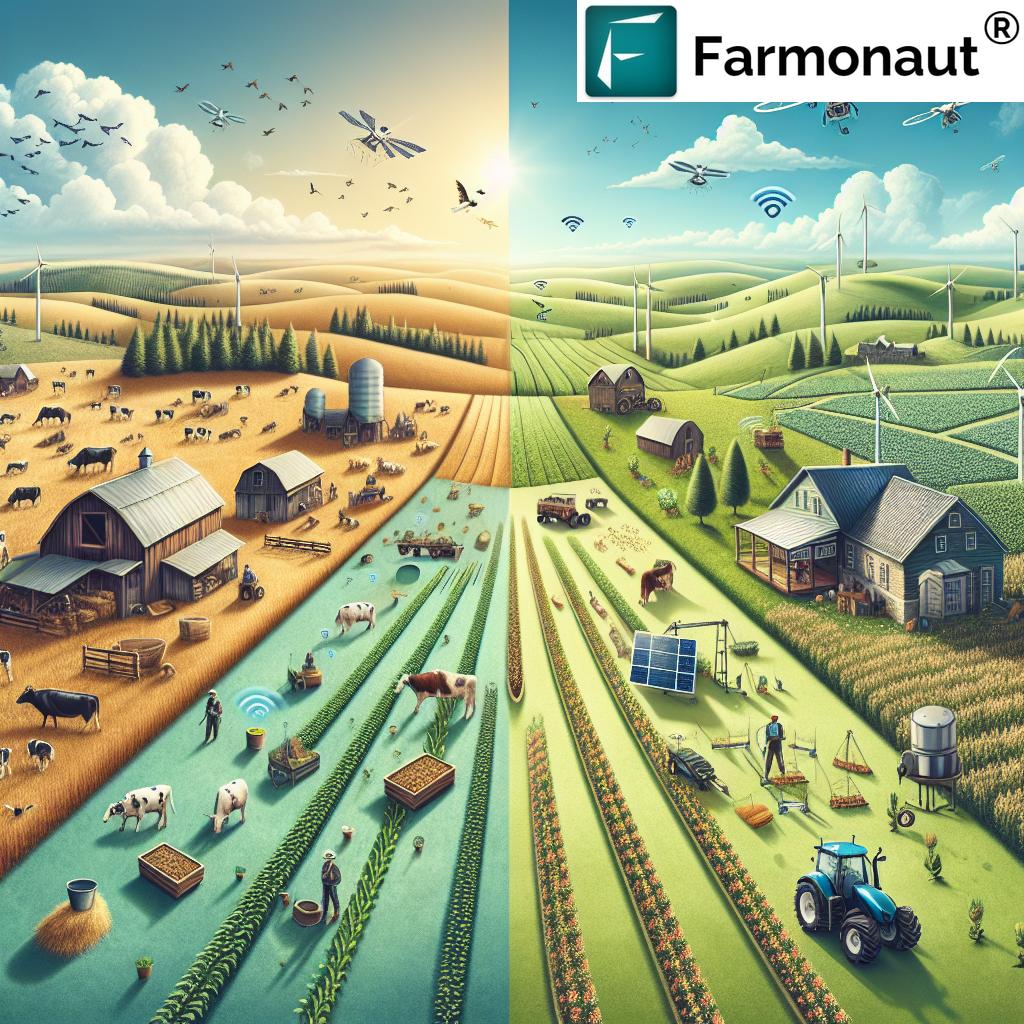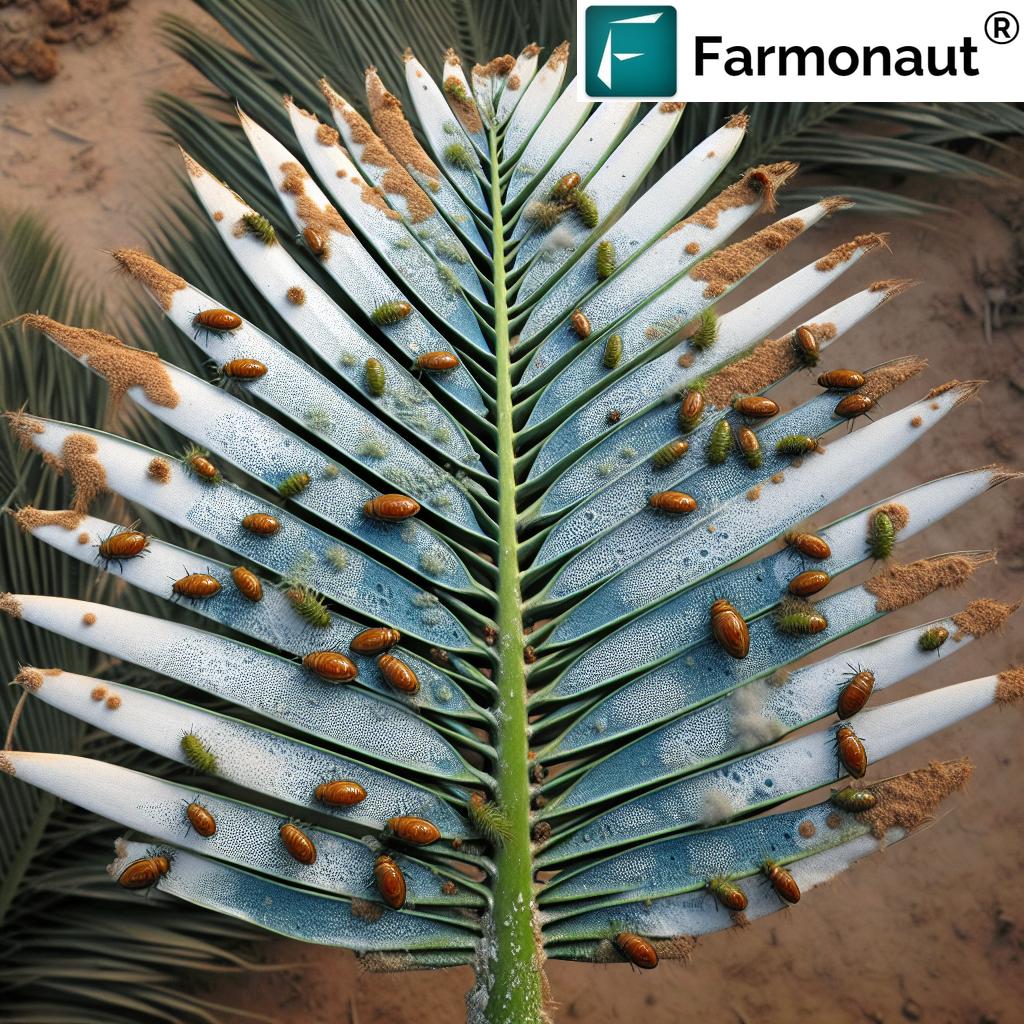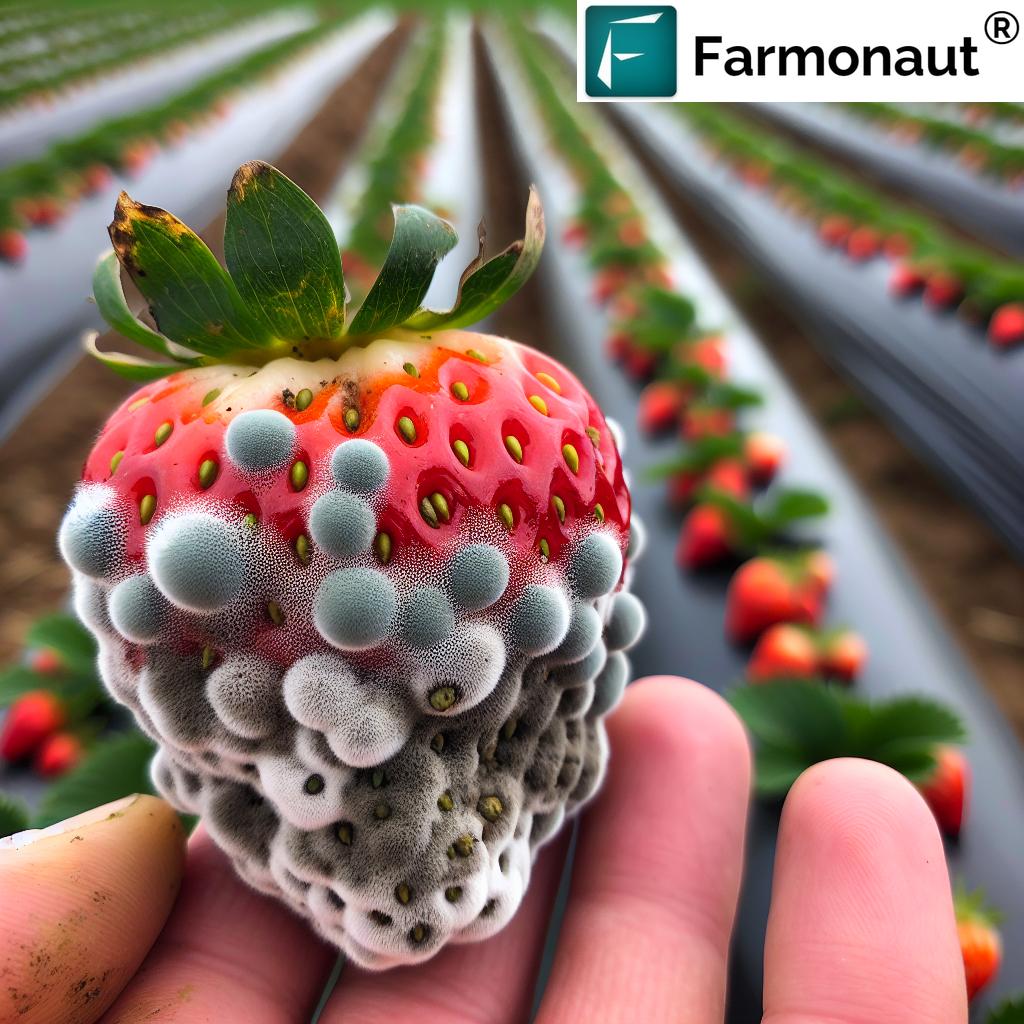10 Methods of Farming: Modern Practices in Agriculture for 2025
Table of Contents:
- Introduction
- Comparative Table: 10 Methods of Farming in Agriculture for 2025
- 1. Traditional Farming
- 2. Modern Intensive Farming
- 3. Organic Farming
- 4. Agroforestry
- 5. Hydroponics and Aquaponics
- 6. Conservation Agriculture
- 7. Precision Farming (Smart Farming)
- 8. Mixed Farming
- 9. Vertical Farming
- 10. Permaculture
- Farmonaut: Transforming Farming Through Technology & Data
- FAQs on Methods of Farming for 2025
- Conclusion
Introduction: Evolving Methods of Farming in Agriculture for 2025
Agriculture, the backbone of human civilization, is undergoing rapid transformation to meet the surging demands of a growing global population. As we approach 2025, the methods of farming in agriculture not only embrace innovation but also emphasize sustainability, resource optimization, and environmental care. Agricultural farming methods must address urgent challenges: climate change, soil degradation, resource scarcity, and the pressure to produce more food with fewer inputs and minimal environmental impact.
This article explores 10 methods of farming that are shaping the future, offering techniques and insights for farmers, agribusinesses, and agri-enthusiasts to thrive in the dynamic world of agriculture. From advanced precision tools and smart digital platforms to traditional organic methods, each system demonstrates how technology, knowledge, and nature can combine for a fertile, resilient, and profitable future.
Comparative Methods Table: 10 Modern Farming Methods for 2025
The table below demonstrates a side-by-side comparison of the key methods of farming in agriculture for 2025. Metrics include main technique, estimated yield increase, water usage reduction, technology level, environmental impact, and best-suited farm scale. These indicators offer a clear, data-driven perspective for farmers and agronomists to select the optimal method tailored to their needs, soil, crops, environment, and available resources.
| Method Name | Main Technique | Est. Yield Increase (%) | Water Usage Reduction (%) | Technology Integration | Environmental Impact | Suitability |
|---|---|---|---|---|---|---|
| Traditional Farming | Manual, Indigenous | 0-10* | 0 | Low | Medium | Small-scale |
| Modern Intensive Farming | High Input, Mechanized | 30-70 | 10-20 | High | High | Large-scale |
| Organic Farming | Organic, Crop Rotation | 15-30 | 20-50 | Medium | Low | Small/Large |
| Agroforestry | Integrates Trees & Crops | 15-40 | 30-60 | Medium | Low | Small/Large |
| Hydroponics & Aquaponics | Soilless, Controlled | 30-80 | 70-90 | High | Low | Urban/Limited land |
| Conservation Agriculture | No-Till, Cover Crops | 10-25 | 30-50 | Medium | Low | Small/Large |
| Precision Farming | Sensor & Data Driven | 20-40 | 20-60 | High | Low | All Scales |
| Mixed Farming | Crops + Livestock | 15-25 | 10-20 | Medium | Medium | Small/Large |
| Vertical Farming | Stacked/Indoor, CEA | 70-100 | up to 95 | High | Low | Urban/Limited land |
| Permaculture | Ecosystem Design | 10-25 | 30-60 | Low-Med | Low | Small/Medium |
*Yield can be increased by integrating traditional methods with new science & technologies
1. Traditional Farming: Indigenous Methods of Agriculture
Traditional farming, known for its deep roots in ancestral knowledge, is primarily practiced for local consumption rather than commercial sale. This method relies on natural inputs such as farmyard manure, compost, crop residues, and crop-livestock integration, avoiding excessive use of synthetic fertilizers or pesticides.
Key Characteristics:
- Manual labor: Heavy dependence on human and animal power for cultivation, sowing, and harvesting.
- Low input, low yield: Traditional methods often yield less per hectare compared to intensive approaches.
- Promotion of biodiversity: Crop rotations, intercropping, and mixed farming techniques protect ecological balance.
- Cultural preservation: These systems maintain and transmit local knowledge and heritage through generations.
- Soil health: Natural fertility enhancement through green manuring and biological practices.
Despite its limitations, traditional farming remains crucial—especially in tribal and smallholder communities in Asia, Africa, and Latin America. Combining indigenous wisdom with scientific research (e.g., integrating satellite and sensor data, or drought-resistant seeds) enables traditional farmers to address climate change, increase yields, and sustain livelihoods in 2025.
2. Modern Intensive Farming: Maximizing Output in Agricultural Systems
Modern intensive farming techniques focus on maximizing productivity from available land by leveraging high-input strategies and cutting-edge technology. By 2025, it’s shaped by efficient machinery, precision input management, advanced analytics, genetically improved seeds, and digital farm management.
Key Features:
- High-yielding seeds and crops: Adoption of improved varieties and hybrids to achieve greater food production.
- Chemical fertilizers and pesticides: Ensures optimal nutrition and crop protection for larger outputs—though requiring careful management to avoid environmental harm.
- Mechanization: Use of tractors, planters, harvesters, and irrigation systems, reducing manual labor and increasing operational scale.
- Precision agriculture: Incorporating data-driven decision-making, GPS guidance, machine learning, and variable rate applications to optimize input use and reduce environmental footprint.
- Resource challenges: Intensive farming can lead to soil degradation, water depletion, and pollution if not regulated or balanced with sustainability practices.
Farmers face the dual challenge of producing enough food while protecting the environment. With the integration of real-time remote sensing, satellite-based crop health monitoring (as offered by platforms like Farmonaut), and smart data analytics, intensive farming now enables farmers to increase yields—and monitor environmental and resource impact—much more effectively.
3. Organic Farming: Growing Towards a Sustainable Future
Organic farming is a method that eschews synthetic chemicals and GMOs, relying instead on natural inputs and sustainable techniques. These systems maintain soil health, support biodiversity, and foster resilience in the face of climate change. Demand for organic produce is expected to rise further by 2025, offering better economic prospects and improved human health.
Key Techniques:
- Biological pest control: Using beneficial insects and companion planting for natural pest suppression.
- Organic fertilization: Incorporation of composted manure, crop residues, and green manure to enrich soil naturally.
- Crop rotation and polycultures: Disrupts pest cycles, improves soil nutrient balance, and reduces the risk of crop failure.
- Soil conservation: Mulching, cover cropping, and reduced tillage to combat erosion and degradation.
- Certification and traceability: Traceable supply chains assure consumers of authenticity and stimulate premium market access. [Explore product traceability solutions for enhanced transparency.]
Innovations for 2025 include the use of biofertilizers, digital pest detection, microbial solutions, AI-based weather insights, and blockchain-enabled traceability. Satellite-driven systems like those by Farmonaut support organic farmers with crop health status, helping them make informed choices about soil fertility, water use, and disease prevention.
4. Agroforestry: Integrating Trees with Crops and Livestock
Agroforestry is a combined system where trees, shrubs, crops, and/or livestock are grown together, yielding multiple benefits for the farm, community, and environment.
Benefits and Practices:
- Soil improvement: Trees fix nitrogen, create habitat for beneficial microbes, and reduce soil degradation.
- Erosion control: Deep roots stabilize topsoil and water ways, safeguarding against wind and water damage.
- Biodiversity boost: Multi-layered planting supports wildlife, pollinators, and ecosystem services.
- Diversified income: Agroforestry farms produce nuts, fruits, timber, fodder, honey, and medicinal crops—all on the same land footprint.
- Climate adaptation: Shade and microclimate effects help buffer crops and livestock from extreme weather.
In 2025, agroforestry is increasingly adopted as a climate-smart method of agriculture, especially in forestry-linked landscapes and degraded marginal lands. Digital monitoring tools can track tree-crop-livestock interactions, optimize cover crop selection, and assess carbon sequestration scores.
For AI-powered agroforestry insights and advisories, platforms like Farmonaut provide real-time data for managing multi-species systems, supporting sustainability and profitability at scale. Discover Farmonaut’s carbon footprinting tools to measure the environmental benefits of agroforestry on your land.
5. Hydroponics & Aquaponics: Soil-less & Water-Efficient Systems
Hydroponics and aquaponics represent a revolutionary shift in agricultural farming methods. Plants are cultivated in a soilless, nutrient-rich water medium, sometimes in vertical stacks for urban and space-limited applications.
Hydroponics:
- Direct water-to-root delivery of minerals and nutrients—maximizing growth rates and yields.
- Water use reduction: Closed-loop hydroponic systems can reduce water use by 70-90% compared to traditional soil-based methods.
- Minimal pesticide needs: Controlled indoor environments limit pest outbreaks, often eliminating chemical pesticide use.
- Year-round production: Climate-controlled facilities allow for continuous cropping.
Aquaponics:
- Combines hydroponic plants with fish (e.g., tilapia, catfish) or other aquatic animals.
- Symbiotic nutrient cycling: Fish waste provides nutrients for plants, while plants purify water for the fish.
- Suitable for urban, peri-urban, and arid environments with poor soil conditions.
By 2025, innovations such as IoT devices, sensors, automation, and remote analytics optimize water, nutrient levels, and light in real time. Farmonaut’s AI-driven crop health monitoring can support hydroponic and aquaponic operations by alerting users to stress or disease signs, ensuring optimal output and reduced waste.
Discover more about smart cultivation and profitability with Farmonaut’s large-scale farm management tools, perfect for modern, high-tech growing systems in agriculture.
6. Conservation Agriculture: Sustaining Soil and Ecosystem Health
Conservation agriculture is a suite of methods that prioritize minimal soil disturbance, permanent soil cover, and crop rotations for long-term sustainability. These techniques ensure that agricultural output today doesn’t compromise productivity for future generations.
Core Principles:
- No-tillage or reduced tillage: Protects soil structure, reduces erosion, and enhances water retention.
- Permanent soil cover: Cover crops (e.g., legumes, grasses) shield bare soil from erosion and maintain soil organic matter.
- Diverse rotations: Multiple crop species rotate throughout the year to break pest and disease cycles, improve fertility, and support biodiversity.
With modern zero-till seeders, specialized cover crop seeders, drone aerial surveys, and cloud-based analytics, conservation agriculture is increasingly accessible for farms large and small. Real-time monitoring of soil health and organic content is made more efficient with platforms like Farmonaut—enabling evidence-based transitions to sustainable farming methods.
7. Precision Farming (Smart Farming): Data-Driven Agriculture
Precision farming—often called smart farming—represents the highest degree of technology integration in agricultural farming methods. By leveraging satellite imagery, drones, soil and crop sensors, AI-driven analytics, and cloud software, this method tailors irrigation, fertilization, and pest management to each specific zone or plant.
Central Elements:
- Field variability monitoring: Use of NDVI (Normalized Difference Vegetation Index) and other indices from satellites or UAVs for crop health assessment.
- Variable rate technology (VRT): Applies water, fertilizer, or pesticide only where and when needed to maximize efficiency and minimize waste.
- Remote management: Real-time dashboard tracking of weather, growth, resource status, and farm machinery for actionable insights.
- Yield mapping and forecasting with AI & ML: Predictive analytics for smarter planting and harvesting decisions.
In 2025, affordable precision agriculture platforms like Farmonaut help farmers of all scales boost yield, reduce input costs, and become more resilient to climate variability. This is vital for optimizing productivity and ensuring the economic viability and environmental sustainability of agribusinesses and smallholder farms alike.
Integrate your existing farm or upgrade new ventures with Farmonaut’s resource and fleet management tools for finest control and operational efficiency.
8. Mixed Farming: Diversification for Resilience
Mixed farming is one of the most enduring methods of agriculture. It combines crop cultivation and livestock rearing on the same farm, ensuring better nutrient cycling, risk management, and economic diversification.
How It Works:
- Nutrient recycling: Manure from animals is returned to the land, enriching the soil and reducing reliance on synthetic fertilizers.
- Income security: If crop yields underperform due to drought or disease, livestock products offer alternative revenue streams.
- Efficient resource use: Crop residues feed animals; animal activity enhances land productivity.
- Fostering sustainability: Biodiversity of species and products strengthens farm resilience against pests, diseases, and market shocks.
By 2025, innovative management techniques, IoT animal tracking, mechanized feed distribution, and AI-based analytics (e.g., health and lactation monitoring) enhance the economic and ecological performance of mixed farming. Farmonaut’s smart agricultural tools can further help track soil, pasture condition, crop-livestock interaction, and resource optimization—bridging centuries-old wisdom and next-generation insights.
9. Vertical Farming: Urban & Space-Efficient Crop Production
Vertical farming is a truly innovative method of farming in agriculture, growing produce in vertically stacked layers or towers, often within climate-controlled, indoor environments. This approach is ideally suited for urban agriculture and areas facing arable land scarcity.
Defining Advantages:
- Water efficiency: Can use up to 95% less water than traditional methods—critical for future-proofing agriculture in water-scarce regions.
- Pesticide-free: Controlled environment drastically reduces pests, eliminating the need for chemical pesticides.
- Year-round production: Insulated from external weather fluctuations, vertical farms yield consistent output regardless of season.
- Minimal land use: Higher yields per square meter, making use of rooftops and degraded urban land.
- Technology-driven: Uses hydroponic/aeroponic systems, artificial lighting (LED), sensors, and robotic harvesting for optimal control.
By 2025, vertical farming is projected to become a cornerstone of the urban food revolution, increasing access to fresh, healthy food in cities and reducing food transport emissions. Farmonaut’s digital platforms assist urban and peri-urban farmers by supplying actionable data on plant stress, light optimization, and integrated water management—essential for precision control and maximum profitability.
10. Permaculture: Designing for Permanent Agriculture
Permaculture goes beyond a farming method—it’s a holistic design philosophy for sustainable, self-maintaining ecosystems. The objective is to work with natural patterns, mimicking the behavior of natural forests and grasslands to create stable, high-productivity landscapes.
Design Principles:
- Ecosystem mimicry: Employs perennial crops, trees, shrubs, groundcovers, and livestock integrated in ways that enhance soil, water, and nutrient cycles.
- Water harvesting: Swales, ponds, and rain gardens maximize efficient use of rainfall and minimize runoff.
- Diversity and polyculture: Multiple plant and animal species support each other, reduce risk, and suppress pests naturally.
- Minimal external inputs: Self-renewing systems reduce (or eliminate) need for added fertilizer, pesticides, or constant tillage.
- Socio-economic empowerment: Enables communities to design resilient food systems matched to local culture and conditions.
Permaculture combines ancient wisdom with 21st-century technology. Tools like Farmonaut’s satellite-based monitoring and AI-advisory can assess the long-term health of soil and biodiversity in complex, mixed systems—blur boundaries between agriculture and ecology—and guide continuous improvement.
For field-scale consultation, explore Farmonaut’s crop plantation advisory platform, designed to empower farmers and communities implementing regenerative and permaculture-inspired farming systems.
Farmonaut: Leading Precision & Sustainable Agriculture in 2025
Farmonaut is pioneering the transition to data-driven, sustainable agriculture worldwide. Our mission is to make precision farming affordable and accessible through advanced technology—empowering farmers, agribusinesses, and institutions to make smarter, more sustainable decisions. We provide expertise and tools for real-time crop health monitoring, carbon footprint tracking, and more:
- Satellite-Based Crop Health Monitoring: Our platform uses multispectral satellite data for timely insights into vegetation health, soil moisture, and resource needs—supporting optimal water and fertilizer use for higher productivity and lower environmental impact.
- AI Advisory (Jeevn): Delivers personalized farm guidance, actionable recommendations, and weather-aware interventions for risk reduction and improved farm performance.
- Blockchain Traceability: With farm-to-market traceability, ensure food safety, transparency, and premium market access for your crops.
- Fleet & Resource Management: Organize and optimize field logistics, machinery, and fuel with digital fleet solutions.
- Carbon Footprinting: Measure and report the environmental impact of your farming practices—find the tools here.
- Crop Loan & Insurance: Enable satellite-verified risk assessment and access to agricultural finance: Learn more.
Our apps (Web, Android, iOS) and API make satellite-driven management accessible globally, serving individual farmers, large agribusinesses, and government agencies. For seamless integration with your digital platform, explore our API developer docs.
FAQs: 10 Methods of Farming in Agriculture for 2025
What are the main challenges modern farming methods address in 2025?
- Resource scarcity: Efficient water, soil, and nutrient management are essential under growing pressure from population and climate change.
- Environmental sustainability: Minimizing chemical inputs, conserving soil, and supporting biodiversity.
- Climate resilience: Adapting to weather extremes and increasing system robustness with integrated methods and technology.
- Food security: Boosting productivity and ensuring quality and safety for a rapidly expanding urban and rural global population.
Which method is best for smallholder farmers?
There is no ‘one size fits all.’ Organic, mixed, and conservation farming often offer quick wins for smallholders, but integrating digital precision tools (such as satellite crop monitoring) amplifies impact and profitability.
Can all these methods be combined?
Yes—most methods of farming in agriculture are synergistic. For instance, you can combine agroforestry with organic or permaculture, or employ precision technologies in vertical and hydroponic farms for optimized yields and sustainability.
How can farmers access affordable precision farming technology?
Farmers can download Farmonaut’s app or use their satellite-based farm management API for real-time, actionable crop and soil insights. Flexible subscription plans make it suitable for all scales—from a few hectares to large agribusiness plantations.
What is the environmental benefit of using technology in agriculture?
Integrating sensors, drones, satellite imagery, and AI allows farmers to target inputs, reduce waste, and understand ecosystem health in real-time, ultimately lowering carbon emissions, water use, and pollution.
Conclusion: 10 Methods of Farming—The Future of Agriculture in 2025
As agriculture and forestry continue to evolve to meet the rising demands and emerging challenges of the 21st century, the 10 methods of farming discussed above reveal the diverse and increasingly integrated nature of modern agriculture. From traditional practices grounded in local knowledge, to organic systems and high-tech precision farming, these methods are essential tools in the global effort to produce healthy, abundant food while protecting soil, water, and biodiversity for generations to come.
Whether you’re a smallholder, commercial grower, agribusiness, or policymaker, choosing and adapting the right methods of farming in agriculture will be crucial as you navigate climate change, market volatility, and rising expectations for sustainable production. Modern platforms like Farmonaut bridge the gap by making smart, affordable, and accessible solutions available to all—helping us collectively optimize land use, monitor risks, conserve resources, and build agricultural resilience.
The future of farming lies in embracing both wisdom and innovation, and in cultivating systems that secure livelihoods as well as planetary health. By continuously refining these 10 key methods of farming, we take a pivotal step towards truly sustainable, high-yield agriculture in 2025 and beyond.
Ready to transform your farm? Explore Farmonaut’s precision agriculture solutions today.










